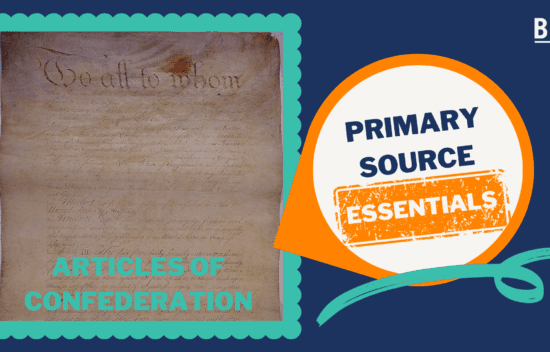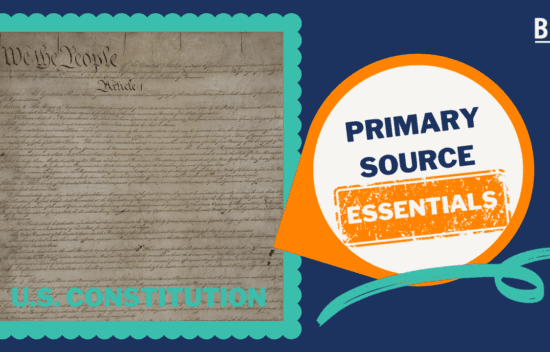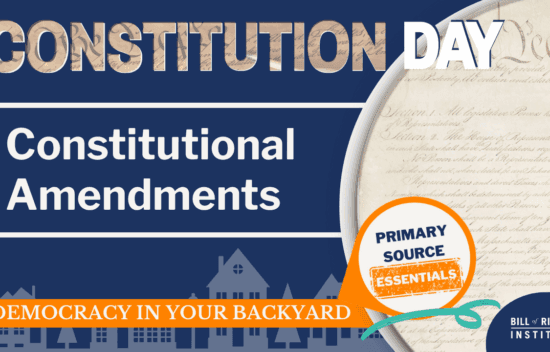



Primary Source Essentials Playlist
21 items

Declaration of Independence | Primary Source Essentials
Video
Video
2 Min
How does the Declaration of Independence support the principles of individual liberty and self-government? In this rapid-fire episode of BRI’s Primary Source Essentials and Declaration of Independence summary, learn the arguments made by the American colonists as they sought to free themselves of British control.
2 Min

Articles of Confederation | Primary Source Essentials
Video
Video
2 Min
Why did the Articles of Confederation fail? In this rapid-fire episode of BRI’s Primary Source Essentials and Article of Confederation summary, learn why the first U.S. national government plan contain critical flaws that prevent its success and how they were addressed when drafting the Constitution.
2 Min

U.S. Constitution | Primary Source Essentials
Video
Video
2 Min
What does the Constitution do? What are the principles of self-government in the Constitution? In this rapid-fire episode of BRI’s Primary Source Essentials and United States Constitution summary, learn how the US Constitution was framed as a stronger, yet limited, government built upon certain principles.
The US Constitution Explained | A Primary Source Close Read w/ BRI: https://billofrightsinstitute.org/videos/the-constitution-explained-a-primary-source-close-read-w-bri
2 Min

The Bill of Rights | Primary Source Essentials
Video
Video
3 Min
How does the Bill of Rights protect individual freedoms and limit government power? In this episode of BRI’s Primary Source Essentials, explore the history and purpose of the Bill of Rights. Learn how the first ten amendments to the Constitution safeguard freedoms like speech, religion, and the right to bear arms, while ensuring protections such as due process and trial by jury. Discover the debates between Federalists and Anti-Federalists that shaped these foundational amendments, and how they continue to protect natural rights, civil liberties, and state powers.
3 Min

Constitutional Amendments | Primary Source Essentials
Video
Video
4 Min
In this episode of Primary Source Essentials, explore the constitutional amendment process and its connection to the founding principle of popular sovereignty.
Learn how the framers designed Article V to balance stability with the ability to adapt, requiring broad consensus for change. Discover how amendments have shaped American history, from the Bill of Rights to the abolition of slavery, the expansion of voting rights, and limits on presidential terms. Understand why the framers made amending the Constitution difficult, how it ensures careful deliberation, and how “we the people” continue to exercise ultimate authority in shaping the nation’s fundamental law.
4 Min

Federalist 10 | BRI’s Primary Source Essentials
Video
Video
2 Min
How did Federalist 10 allow the Founders to create a Constitution with a stable and lasting form of government? In this rapid-fire episode of BRI’s Primary Source Essentials and Federalist 10 summary, learn the arguments from James Madison, who wrote Federalist 10. Discover why the Federalists believed a large republic was key to the Constitution and other Federalist 10 main points.
Primary Source Essentials Federalist 10 Handout: https://bri-docs.s3.amazonaws.com/PSE+Federalist+10+Handout.pdf
2 Min

Federalist 51 | Primary Source Essentials
Video
Video
3 Min
What are the main Constitutional principles that help limit government? In this rapid-fire episode and Federalist 51 summary of BRI’s Primary Source Essentials, learn the arguments made by James Madison, who wrote Federalist 51, in Federalist 51. The Federalist 51 main points explain why he believed the constitutional checks and balances put in place would help create a limited government.
3 Min

Federalist 70 | Primary Source Essentials
Video
Video
2 Min
What were the essential characteristics of the executive branch according to Federalist 70? In this rapid-fire episode and Federalist 70 summary of BRI’s Primary Source Essentials, learn the arguments made by Alexander Hamilton, who wrote Federalist 70, in Federalist 70. Discover the Federalist 70 main points and why he believed in a strong executive branch to protect liberty and self-government.
2 Min

Federalist 78 | Primary Source Essentials
Video
Video
2 Min
What is the judiciary’s role in the American constitutional system according to Federalist 78? In this rapid-fire episode of BRI’s Primary Source Essentials and Federalist 78 summary, learn the arguments made by Alexander Hamilton in Federalist 78 and why he believed the judicial branch was the least dangerous and an essential part of the system of checks and balances.
2 Min

Brutus 1 | BRI’s Primary Source Essentials
Video
Video
3 Min
Why did the Anti-Federalist so strongly oppose the proposed Constitution? In this rapid-fire episode of BRI’s Primary Source Essentials and Brutus 1 summary, learn the arguments made in Brutus 1 against the Constitution. Discover why the Anti-Federalists feared a large republic and other Brutus 1 main points.
Primary Source Essentials Brutus 1 Handout: https://bri-docs.s3.amazonaws.com/PSE+Brutus+1+handout.pdf
3 Min

Gettysburg Address | Primary Source Essentials
Video
Video
3 Min
How did President Lincoln outline his view of democracy in the Gettysburg Address? In this rapid-fire episode of BRI’s Primary Source Essentials, learn how President Lincoln appealed to all Americans to preserve and fulfill the ideals of liberty, equality, and self-government. Discover the main points discussed in the Gettysburg Address and how this document showcased President Lincoln's view on democracy.
3 Min

Declaration of Sentiments | Primary Source Essentials
Video
Video
3 Min
What were the claims the Declaration of Sentiments made on equality and self-government for women? In this rapid-fire episode of BRI’s Primary Source Essentials, learn why Lucretia Mott and Elizabeth Cady Stanton called for the Seneca Falls Convention. Discover the main points discussed in the Declaration of Sentiments and how this document helped pave the way for the Women's Suffrage Movement.
3 Min

Letter From Birmingham Jail | Primary Source Essentials
Video
Video
How does Martin Luther King, Jr. support justice and equality in “Letter From Birmingham Jail?” In this rapid-fire episode of BRI’s Primary Source Essentials and letter from Birmingham jail analysis, learn about the MLK letter from Birmingham jail while he was imprisoned for leading nonviolent civil rights demonstrations in Alabama in 1963. This letter from Birmingham jail summary explains why he thought people had a responsibility to follow just laws and a duty to break unjust ones.

The Truman Doctrine | Primary Source Essentials
Video
Video
3 Min
How did the Truman Doctrine expand American global commitments to preserving democracy during the Cold War? In this rapid-fire episode of BRI’s Primary Source Essentials, learn how President Truman appealed to Congress to deliver aid to Greece and Turkey and the commitment of the United States to contain Soviet expansion around the globe. Discover the main points discussed in the Truman Doctrine and how this document fit in well with American foreign policy.
3 Min

The Northwest Ordinance | Primary Source Essentials
Video
Video
3 Min
How did the Northwest Ordinance shape the expansion of the United States in the early republic? In this rapid-fire episode of BRI’s Primary Source Essentials, explore how the Confederation Congress established a process for admitting new states to the Union with the Northwest Ordinance of 1787. Learn about the three-step process for statehood, the protection of essential rights, the promotion of education, and the ban on slavery in the Northwest Territory. Discover how this critical ordinance laid the foundation for the creation of five states—Ohio, Michigan, Indiana, Wisconsin, and Minnesota—and promoted republican principles of self-government and a healthy civil society.
3 Min

Andrew Jackson’s Bank Veto | Primary Source Essentials
Video
Video
3 Min
How did President Andrew Jackson’s National Bank veto reshape federal power in the United States? In this rapid-fire episode of BRI’s Primary Source Essentials, explore why Jackson opposed the National Bank and how his veto marked a pivotal moment in American history. Discover Jackson's arguments, including concerns about constitutionality, the creation of an economic aristocracy, foreign influence, and state versus federal authority. Learn how this decision shaped the future of federal power and set a precedent for presidential authority in interpreting the Constitution.
3 Min

Emancipation Proclamation | Primary Source Essentials
Video
Video
4 Min
In this episode of Primary Source Essentials, explore how President Lincoln's Emancipation Proclamation. Learn how Lincoln used his war powers to strike at slavery in the rebellious states. Discover how Congress and Lincoln worked together to pass Confiscation Acts, ban slavery in U.S. territories, and enlist formerly enslaved men in the Union army. Understand the limits of the proclamation, Lincoln’s fear of Supreme Court reversal, and his push for the 13th Amendment to abolish slavery permanently.
4 Min

Frederick Douglass’ Fourth of July Speech | Primary Source Essentials
Video
Video
3 Min
What were Frederick Douglass’s views on slavery, the Constitution, and the Founding documents? In this episode of BRI’s Primary Source Essentials, discover the powerful voice of Frederick Douglass as he critiques the injustice of slavery while affirming the promise of American ideals. Explore how Douglass evolved from sharing his personal experiences to becoming one of the most powerful intellectual forces of the abolitionist movement. Learn how he broke from William Lloyd Garrison, embraced the Constitution as a “glorious liberty document,” and demanded that the United States live up to the principles of the Declaration of Independence.
3 Min

Washington’s Farewell Address | Primary Source Essentials
Video
Video
3 Min
What were the governing principles George Washington established in his Farewell Address? In this episode of BRI’s Primary Source Essentials, explore Washington’s 1796 Farewell Address, where he laid out his vision for a lasting republic. Learn how he emphasized national unity, warned against political factions, and advised a foreign policy based on justice and neutrality. Discover how Washington’s insights continue to guide American political thought and why his Farewell Address remains a foundational text in U.S. history.
3 Min

Prince Hall Freedom Petition | Primary Source Essentials
Video
Video
3 Min
How did enslaved individuals use natural rights arguments to fight for freedom? In this episode of BRI’s Primary Source Essentials, delve into the 1777 Prince Hall Freedom Petition to the Massachusetts legislature. Learn how Prince Hall and other petitioners asserted their natural and unalienable rights, condemning slavery as a violation of their humanity and liberty. Explore their efforts to claim ownership of their rights and the broader emancipation movement that emerged in northern states after the Revolution. Discover the lasting impact of these arguments in confronting the paradox of slavery and freedom in the American Republic.
3 Min

William Lloyd Garrison’s The Liberator | Primary Source Essentials
Video
Video
3 Min
What were William Lloyd Garrison’s views on abolition and the Founding documents? In this episode of BRI’s Primary Source Essentials, dive into the bold abolitionism of William Lloyd Garrison. Discover how he evolved from supporting gradual emancipation to demanding the immediate end of slavery, invoking the Declaration of Independence’s natural rights principles. Learn about his fiery rhetoric in The Liberator, his refusal to compromise, and his controversial stance on the Constitution. Explore how Garrison’s relentless pursuit of justice helped shape the abolitionist movement and challenged America to live up to its founding ideals.
3 Min